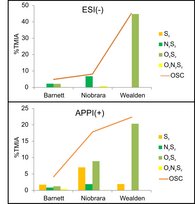Insights into Organic Sulfur Compounds (OSC) in different source lithofacies, depositional environments and maturity series using FT-ICR-MS
Organic sulphur compounds (OSCs) represent one of the main forms of sulphur in sedimentary rocks. The abundance and distribution of OSC are influenced by depositional environment and thermal maturity, as revealed through the application of various methods, e.g., GC-MS, Py-GC-MS and XANES. The main motivation of this study is to characterize OSCs in ultra-high resolution by Fourier Transform Ion Cyclotron Resonance Mass Spectrometry (FT-ICR-MS) combined with different ionization methods (atmospheric pressure photo ionization (APPI) running in positive-ion mode and electrospray ionization (ESI) running in the negative-ion mode). The broad analytical window of FT-ICR-MS provides new insight into these compounds and their roles and behavior in different systems over geological times, leading to improved process understanding. Samples from Barnett Shale, Niobrara Formation and Wealden Formation were selected to evaluate the effect of lithofacies, depositional environments and maturities on composition and distribution of OSCs.
Goals
- Characterizing the fundamental differences in the composition of heteroelements, with focus on OSC, of different source lithofacies (siliceous, carbonate rich and argillaceous settings)
- Characterizing the maturity-driven generation and transformation of heteroelements, with focus on OSC, from marine and lacustrine depositional environment
Participants
- Huiwen Yue (Ph. D Student at GFZ)
- Dr. Andrea Vieth-Hillebrand (GFZ)
- Dr. Yuanjia Han (GFZ)
- Dr. Stefanie Pötz (GFZ)
- Dr. Mareike Noah (GFZ)
- Prof. Dr. Brian Horsfield (GFZ)
Funding
- Chinese Scholarship Council (CSC)



